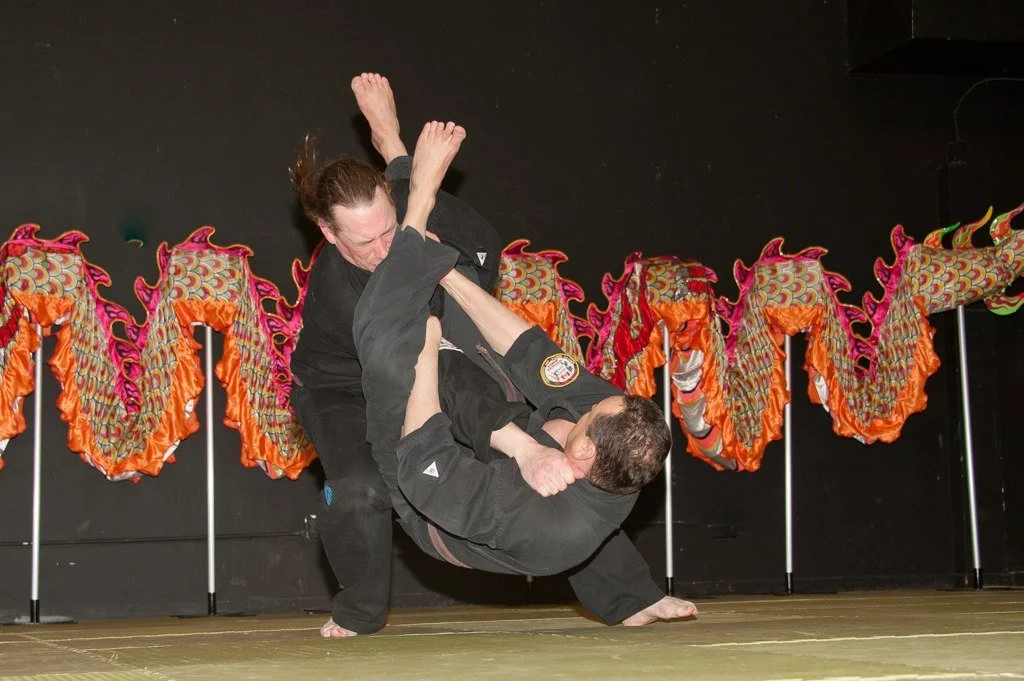Wuxin- Black Stripe
(As explained by Sifu Jeff Brinker, November 7, 2024)
The difference between syllabus and curriculum has been defined for years. Unfortunately, we sometimes still struggle with the differences and keeping them in perspective while we are actively teaching on deck.
Syllabus- the tools we use to teach
Curriculum- what we are actually trying to teach
Intellectually, we understand. Practically, we are struggling.
Using the syllabus as a checklist is an incorrect approach. We do not teach the syllabus; if the students know the tools, that does not yet mean they know the curriculum, the heart of our lessons. It is likened to knowing how to use a hammer; many of us know how to use a hammer, but that does not mean we know how to build a house. Our goal is to build a house, the curriculum, not teach about a hammer, the syllabus.
As it has been instructed by Sifu Brinker, the Black stripe will not be given to a student until all other stripes have been earned.
This is not without its reasoning. The Black stripe, Wuxin, translates to “No Mind”. It is the idea of “Knowledge Applicability”. The ability to properly execute a technique cannot be present if a student has not yet earned, sufficiently to their rank, the Yellow, Red or White stripes. How can they be properly applying their knowledge if they have yet to earn/adequately learn their Vocabulary of Motion, Keystone Principles, Six Harmonies?
Wuxin means No Mind
“What we mean by that is, these techniques are yours. You don’t have to think about them, you don’t have to intellectualize them. You just need to execute them and you know how to execute them.”
How can you execute a technique if you are not able to move in a way that allows you to earn Yellow, Vocabulary of Motion, or Red, Keystone Principles, or White, the Six Harmonies?
In order to have Wuxin, you must perform your Vocabulary of Motion, Keystone Principles and Six Harmonies to your rank.
At a minimum.
Because Wuxin is last, it can serve as a “catch all”; stripes that had been earned earlier need to be kept up to expectations in order to earn the Black stripe. Therefore it is again impossible to earn Black before the others.
“Black stripe means you know how to apply your knowledge. If you know how to apply your knowledge then you have the knowledge.”
Therefore, all other stripes must be earned first.
Curricular Rotation

Starting this month, we are planing to start a curricular rotation for both the kids and adult classes. Part of the reason is to decrease the differences in skill and knowledge between the two.
Although our approach for each class needs to be very different, the skills and development at each level should be the same.
In an effort to determine the validity of our current set rotation, we will be documenting what activities and lessons we give in each class. We need to track and control as many variables as possible in order to determine if the rotation will work in its current state, or if we need to rethink the rotation/approach. The spreadsheet that you will be given access to is where we will be tracking both the rotation and what is covered in each class. It would be ideal if we also wrote out what our intent/approach was for each lesson, our successes and the weaknesses we noted and anything that would help us sharpen our skills and leave breadcrumbs for the next instructor.
Although we need to merge the classes, we still need to approach each class and each lesson with the needs of the students foremost in our minds. This means that we all, as leading instructors, need to plan our classes before we hit the mats, and need to make our plan while taking into consideration what the previous instructors have been teaching, what the students need to progress, and what is next in the rotation. We can’t just come unprepared and pick a lesson based on our strengths or comfort zone; in order for this to work as intended we will all need to innovate and look at the classes as a whole instead of as a single night of lessons.
Something to keep in mind, and I’m sure something we will all need to be reminded of periodically, is that we are teaching a curriculum, a set of concepts and ideals. Not a list of exercises. The syllabus, the document that lists all of the kicks, punches, applications, etc., is only a list of tools we have to help teach the curriculum, and we need to remember to approach it as such. The goal in teaching our students the Six Harmonies is NOT to teach them a long list of forms, but rather to use those forms to increase their awareness and ability to apply the Six Harmonies. Each form is useful to help us in different ways- that is what we need to be thinking of when we are teaching them. What is it about this form that further advances our goal of teaching the Six Harmonies? What concepts are hidden within it?
We are always trying to refine our approach. Hopefully, this rotation will help us ensure the success of all of our students while making the transition between programs or levels easier and more streamline. We have lost students in the past due to the culture shock, and although there always has to be differences between the classes, perhaps we can soften the shock for students as they progress in the system.
Guiding Principles
The best way to structure and properly build our curriculum starts with deciding what we want our end product to look like. What type of student (black belt) do we want to produce? This is outlined by our Curriculum Ideals.
Currently, my curricular ideals are not completely defined. While they clearly state what each stripe colour represents, there is not enough guidance provided for developing the intangible internal qualities of the green stripe.
Similarly, the tangible external qualities of my curricular ideals are not concisely defined. They should be able to be reduced to basic principles that are present in every technique and application. These principles should apply to both offence and defence so that you can weaken your opponent by eliminating one or more of the principles from his vocabulary of motion. Perhaps these are the ‘Eighteen Concepts’ I am always referring to.
Requirements for belt testing are not the same as the requirements for striping. Striping should be about building up the character of the student and instilling the foundational values that will help them develop into a solid SRKF black belt. Therefore rank testing should be about the keystone principles and six harmonies to ensure the proper style foundational basics are present along with a constant progression of those same foundational basics.
If we continue with seven stripes (black, red, orange, yellow, green, blue, white), two of the stripes (white and red) would contain the physical foundation upon which a skilled black belt is built. These two stripes would constitute the testing portion of the syllabus because these two ideals contain the information that defines how we move and adapt - our style. The other five stripes would represent supporting ideals that are important but not necessarily tested on.
This approach will only work if instructors are holding the line on striping standards. If we clearly define the standard then the standard must be consistently enforced. If an instructor does not understand the standard, the onus is on them to educate themselves by asking questions and suggesting revisions to help refine our standard definitions.
Jeff Brinker


